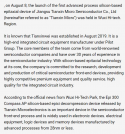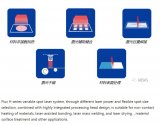You posted this in the work news section? Why are you posting this again? To make yourself feel good about the news?China Graft Probes Stem From Anger Over Failed Chip Plans
Source:
Bloomberg - Are you a robot?
Non paywall:
You are using an out of date browser. It may not display this or other websites correctly.
You should upgrade or use an alternative browser.
You should upgrade or use an alternative browser.
Chinese semiconductor industry
- Thread starter Hendrik_2000
- Start date
- Status
- Not open for further replies.
China Graft Probes Stem From Anger Over Failed Chip Plans
Source:
Bloomberg - Are you a robot?
Non paywall:
The biggest irony in all of this is that the gasoline that is currently driving the Chinese semiconductor industry forward is fear of US sanctions. As I said before in my previous posts, the Americans did what the Chinese government couldn't do in decades, strike enough fear into the Chinese semiconductor and electronics industry for companies to reconsider localizing their supply chain, something that was unthinkable before the sanctions on Huawei and ZTE no matter how much money the Chinese invested in the industry.
Before the current events, the Chinese semiconductor industry was an even larger disjointed monstrosity, with each of its sectors not trusting the others.
Electronics manufacturers did not even consider buying from local design houses, even for their low-end products and even if their products had similar performance to foreign ones.
Semiconductor design houses have not even remotely entertained the idea of using local EDA and IP or partnering with local EDA-IP companies, even with alternatives. Empyrean EDA's largest licensors were foreign companies. They also avoided manufacturing even their low-end ICs with local companies.
Chinese semiconductor foundries avoided buying or collaborating with local equipment manufacturers, software vendors, and materials suppliers, preferring to establish long-term relationships with foreign (especially American) suppliers even if the threat of export controls was ever present.
Chinese equipment manufacturer preferred to buy parts from foreign suppliers even if the same parts were available locally.
All of this created a disjointed industry that was "growing" because of government money but going nowhere, factories sitting idle with hardly any customers, design houses not growing, equipment manufacturers (such as NAURA and SMEE) trying to survive in niche markets such as solar energy and packaging, it was said that working for an SME was a dead end job with little growth, now they are receiving raises.
Don't get me wrong, US sanctions of course hurt Chinese companies, especially companies that developed an addiction to US products, BUT like the asteroid that killed the dinosaurs and gave rise to mammals, this is an once in a lifetime opportunity for Chinese companies to gain confidence in their products, to improve their products, to win customers and gain experience. If all goes well, China could finally have a jointed semiconductor industry moving forward. Something that will never happen under normal conditions, no matter how much money the Chinese government invests in the industry.
Before the current events, the Chinese semiconductor industry was an even larger disjointed monstrosity, with each of its sectors not trusting the others.
Electronics manufacturers did not even consider buying from local design houses, even for their low-end products and even if their products had similar performance to foreign ones.
Semiconductor design houses have not even remotely entertained the idea of using local EDA and IP or partnering with local EDA-IP companies, even with alternatives. Empyrean EDA's largest licensors were foreign companies. They also avoided manufacturing even their low-end ICs with local companies.
Chinese semiconductor foundries avoided buying or collaborating with local equipment manufacturers, software vendors, and materials suppliers, preferring to establish long-term relationships with foreign (especially American) suppliers even if the threat of export controls was ever present.
Chinese equipment manufacturer preferred to buy parts from foreign suppliers even if the same parts were available locally.
All of this created a disjointed industry that was "growing" because of government money but going nowhere, factories sitting idle with hardly any customers, design houses not growing, equipment manufacturers (such as NAURA and SMEE) trying to survive in niche markets such as solar energy and packaging, it was said that working for an SME was a dead end job with little growth, now they are receiving raises.
Don't get me wrong, US sanctions of course hurt Chinese companies, especially companies that developed an addiction to US products, BUT like the asteroid that killed the dinosaurs and gave rise to mammals, this is an once in a lifetime opportunity for Chinese companies to gain confidence in their products, to improve their products, to win customers and gain experience. If all goes well, China could finally have a jointed semiconductor industry moving forward. Something that will never happen under normal conditions, no matter how much money the Chinese government invests in the industry.
Not just the semiconductor industry. I believe all Chinese industries are working toward self-relianceThe biggest irony in all of this is that the gasoline that is currently driving the Chinese semiconductor industry forward is fear of US sanctions. As I said before in my previous posts, the Americans did what the Chinese government couldn't do in decades, strike enough fear into the Chinese semiconductor and electronics industry for companies to reconsider localizing their supply chain, something that was unthinkable before the sanctions on Huawei and ZTE no matter how much money the Chinese invested in the industry.
Before the current events, the Chinese semiconductor industry was an even larger disjointed monstrosity, with each of its sectors not trusting the others.
Electronics manufacturers did not even consider buying from local design houses, even for their low-end products and even if their products had similar performance to foreign ones.
Semiconductor design houses have not even remotely entertained the idea of using local EDA and IP or partnering with local EDA-IP companies, even with alternatives. Empyrean EDA's largest licensors were foreign companies. They also avoided manufacturing even their low-end ICs with local companies.
Chinese semiconductor foundries avoided buying or collaborating with local equipment manufacturers, software vendors, and materials suppliers, preferring to establish long-term relationships with foreign (especially American) suppliers even if the threat of export controls was ever present.
Chinese equipment manufacturer preferred to buy parts from foreign suppliers even if the same parts were available locally.
All of this created a disjointed industry that was "growing" because of government money but going nowhere, factories sitting idle with hardly any customers, design houses not growing, equipment manufacturers (such as NAURA and SMEE) trying to survive in niche markets such as solar energy and packaging, it was said that working for an SME was a dead end job with little growth, now they are receiving raises.
Don't get me wrong, US sanctions of course hurt Chinese companies, especially companies that developed an addiction to US products, BUT like the asteroid that killed the dinosaurs and gave rise to mammals, this is an once in a lifetime opportunity for Chinese companies to gain confidence in their products, to improve their products, to win customers and gain experience. If all goes well, China could finally have a jointed semiconductor industry moving forward. Something that will never happen under normal conditions, no matter how much money the Chinese government invests in the industry.
Q3 2024 China will have interesting news about itThis means China will crack EUV by 2025 and SMIC will bankrupt TSMC by 2030, thereby triggering peaceful reunification just before Xi's term ends.
I am dead serious. This guy along with G-man are reverse voodoo dolls. They are both Great Helmsmen, relentlessly steering China towards the path of national rejuvenation.
Damn, if only it was true :/It's a joke, cus Biden's so senile and stupid everything he says is proven wrong in short order just like his claims of America's economy booming right before it goes into recession, which, btw, is no longer defined as 2 straight quarters of negative growth because... you know... democrats.
Tianxin Micro's first advanced process-based silicon fusion device launched
View attachment 95211
With the development of IC manufacturing to smaller feature line widths and thinner epitaxial layers, the quality requirements of integrated circuit devices for epitaxial wafers continue to increase. The advancement of advanced logic and storage processes has opened up more application scenarios for epitaxial processes. Higher requirements are put forward for the function and performance of the epitaxy system. Epi 300 Compass AP is a decompression epitaxy equipment for advanced logic foundry and storage, as well as epitaxy process application requirements in power devices. It has advanced infrared heating control technology and heating module design, which can achieve rapid temperature rise and fall and temperature The precise control of the field enables the system to have excellent process repeatability and equipment stability, resulting in good thickness uniformity, resistivity uniformity, zero slip line and low defect density epitaxial layer growth. It can meet the requirements of process uniformity control, low crystal defects, low doping and strong controllability of particle density. We not only provide process machines with high stability and high output, as well as spare parts and after-sales service, but also provide related process solutions.


- Status
- Not open for further replies.




